In Leshan there are two main attractions which were included in the China World Cultural and Natural Heritage List in 1996. These two scenic areas are the pride of local residents.
 Leshan Giant Buddha
Leshan Giant Buddha Mount Emei
Mount Emei Jiayang Steam Train
Jiayang Steam Train
Cultural Relics
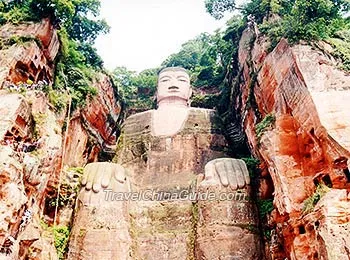 |
| Giant Buddha |
Leshan Giant Buddha Scenic Area
The world-famous Giant Buddha is carved into the western river cliff face of Lingyun Mountain overlooking the confluence of the Min, Qingyi and Dadu rivers. This classic statue is of great religious significance and was created in the belief that it would influence the turbulent waters of the rivers and protect shipping. It stands as a great tribute to the skills of the stone carvers who created it and is part of a long tradition of religious stone-carving works. The so called 'Giant Sleeping Buddha' lies across Wuyou Mountain, Lingyun Mountain and Guicheng Mountain and it is a marvelous natural spectacle. When viewed from Leshan dock, the outline of the Giant Sleeping Buddha can be clearly seen. The man-made Maitreya Buddha can be seen seated at the heart of the Giant Sleeping Buddha.
When you are in Leshan Scenic area, many other attractions await your patronage: the Oriental Buddha Park located among Leshan mountain ranges is a themed park featuring joss stone inscriptions; Lingyun Temple on Lingyun Mountain; Mahao Cave-Tomb Museum contains China's earliest joss stone inscription; Wuyou Mountain is where the head of the Giant Sleeping Buddha is located and many pavilions have been built here.
Giant Sleeping Buddha: It is a natural wonder formed by Wurou Mountain, Lingyun Mountain and Guicheng Mountain. This Buddha lies on his back at the junction of the Min River, Qingyi River and Dadu River with his head towards the south and feet towards the north.
Wurou Mountain forms the Buddha's head; the base of the hill forms his hair worn in a bun; Jingyun Pavilion forms his eyelashes; and the crown of trees on the peak constitutes his forehead, nose, lips and jaw. The Buddha's body is made up of nine peaks along Lingyun Mountain as his massive chest, waist and strong legs. His turned-up feet are formed by the southern slope of the Guicheng Mountain. The most stunning view is from across the Minjiang River showing the Giant Buddha seated at the heart of the Giant Sleeping Buddha. It is a marvelous spectacle and imparts the idea of 'the Buddha existing within Buddha'.
Seen from the Leshan dock in the east of the ancient city of Leshan, the outline of the giant Buddha is very clear. It seems like a dignified Buddha peacefully sleeping on his back. The lifelike shape surrounded by beautiful mountain and waters offers a feast to the eyes.
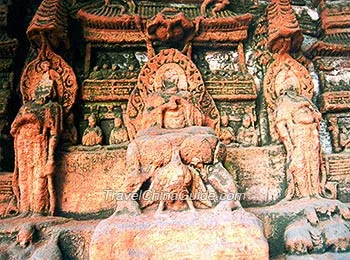 | | Stone Carvings near the Giant Buddha | | 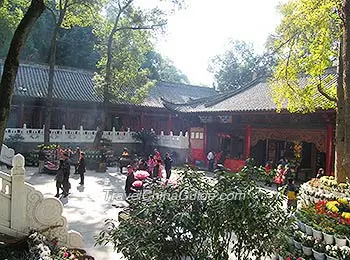 | | Main Hall of Lingyun Temple | |
 Natural Landscape
Natural Landscape
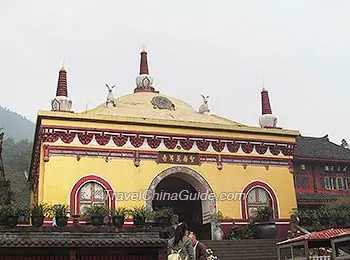 |
| Brick Hall in the Wannian Temple, Mount Emei |
Mount Emeishan Scenic Area
Mount Emei is located to the southwest of Leshan City and is one of China's four mountains sacred to Buddhism. It is regarded as the 'wonderland of celestial being' and many things to do here are worthy of a visit.
Four Scenic Regions: These are the Baoguo Temple, Wannian Temple, Qingyin Pavilion, and Golden Summit. From the Golden Summit, tourists can experience the magic of the 'Buddha Rays' which can be viewed between 14:00 to 18:00 during fine weather in autumn and winter. When you climb Emeishan Mountain, you will find dangerous paths, steep rocks, surprising springs and waterfalls. These all may give you the feeling that your journey is as difficult as reaching for the sky. However, you are sure to be delighted by the flocks of monkeys on Mount Emei as they are very lovely and well-mannered. When the tourists give food to them, they pick it up turn and turn about and never squabble to be first.
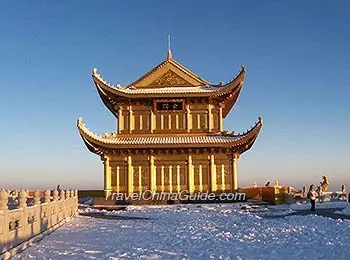 |
| Golden Summit of Mount Emei |
The snow scenery on Mount Emei is very attractive as winter arrives. Unlike on other mountains, in winter the trees on Mount Emei remain green. That's the highlight! Another highlight must be Mount Emei Ski Resort (Leidongping Ice -skating Recreation Site) which is located at the ropeway area under the golden summit. The surrounding environment is fairly good and the Italian ski equipment provided caters for the needs of those who enjoy winter sports. For those who like skiing, this is really an excellent resort. It is normally open from October until March, and each January the grand 'South Ice-Snow Festival' takes place here. Tips on Skiing for your reference
 Tips:
Tips:
The best times to visit different scenic aspects of Mount Emei are shown in the table below:
| Scenery | The Best Time to Visit |
| Sunrise | 06:00 (in summer) 07:00(in winter) |
| Cloud sea | 09:00-10:00 15:00-16:00 |
| Buddha rays | 09:00-10:00 15:00-16:00 |
| Watching monkey flocks | June - September |
| Skiing | November - March |
| Azalea blossom | May - June |
| Autumnal Shades of red and gold | October |
- Last updated on Jul. 12, 2022 -

![]() Natural Landscape
Natural Landscape

![]() Tips:
Tips:
